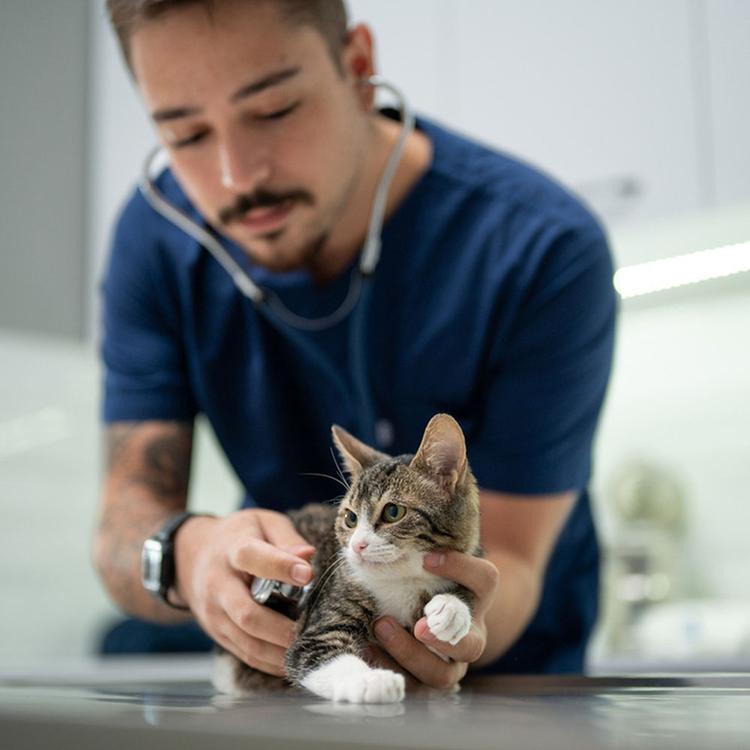Vet Bill Assistance: Get Help with Vet Bills
Dealing with high vet bills? See assistance options for affordable pet care. Get the support your pet needs without breaking the bank.
Dealing with high vet bills? See assistance options for affordable pet care. Get the support your pet needs without breaking the bank.
by Janelle Leeson, | March 15, 2024

Nataliya Vaitkevich / Pexels
I don’t know about you, but even the cost of a routine vet bill can catch me off guard. An unexpected vet bill can be downright overwhelming, right up there with those student loans you had to start paying again last year.
“The key is to know ahead of time the likely costs of caring for your pet so you can prioritize what your pet really needs with what you can afford,” says Jonathan Wainberg, financial pet expert at CareCredit Pet. That sounds great at face value, but what if you’ve just adopted your pet or they have a pre-existing condition not covered by insurance?
Fortunately, financial assistance for vet bills is out there, but finding it may take some research. Animal welfare organizations, charities, and nonprofit groups often provide financial aid for pet care. Some veterinary clinics may also offer payment plans or discounted services for pet parents facing financial constraints. Below, we lay out some options.
You can expect to see your vet fairly often — about once a year for healthy adult dogs and cats, every three to four weeks for puppies getting their first vaccine series, and twice a year or more for senior pets or those with health conditions. While we all hope that emergency visits aren’t needed in between, it’s an unfortunate possibility. Here’s what you can expect to pay at the vet.
The total cost of a vet visit isn’t so straightforward. First, you’ll need to pay for the wellness exam, which typically ranges from $65 to $100. Additional costs will vary based on the services your veterinarian recommends and the going rate of services in your area:
Booster shots for your pet’s vaccines: $20 to $95 per shot
A heartworm test for your dog: $35 to $75
A 4Dx Snap Test to screen for tick-borne infections: $20 to $50
A complete blood count or blood panel: $95
If your pet is due for preventive flea, tick, and heartworm medications, you can tack on $40 to $100 if you choose to purchase them at your appointment.
The cost of an emergency visit alone typically ranges from $100 to $150, approximately double the amount you pay for a routine wellness visit. Because you’re here for something more urgent or serious, you likely won’t get away with just that charge. Perhaps your pet was injured and needs stitches or even a bone set. Your pet may undergo diagnostic examinations such as blood work, X-rays, ultrasounds, or a CT scan. The cost is worth it, though, because a trip to the ER can save your pet’s life.
According to a recent survey by Forbes Advisor, 63 percent of pet parents are struggling or would struggle to pay for a surprise vet bill. Here are eight real solutions to lessen the burden of a vet bill without sacrificing your pet’s care.
Don’t assume that the estimated price of services is final; ask for some wiggle room. Vet clinics may offer discounts for those who qualify for low-income assistance.
Also, simply asking to consult with another vet in the same hospital or at another clinic could lead to a less expensive treatment option, such as trying medication before considering surgery. While this approach may take longer or be slightly less effective, it can still ensure your pet lives comfortably
When scheduling your appointment, ask about seeing a vet tech or veterinary nurse rather than a doctor, they can typically administer vaccines without the hefty appointment price.
Even if your vet clinic can’t cut you a deal on the lump sum, they may be open to a monthly payment plan. Just keep in mind that payment plans usually come with strings attached — there may be interest rates to consider.
Explore options for more affordable veterinary care by reaching out to other vets or clinics. Be upfront about your budget beforehand and ask if they can provide a treatment plan that fits within it.
Local animal welfare organizations, rescue groups, and shelters frequently provide affordable vaccinations, spaying, and neutering services, along with other routine care options. Resources, such as PetSmart’s Charities database and SpayUSA’s referral network, for free and low-cost spay-and-neuter services can help in locating services in your area.
Another low-cost veterinary clinic in your area might include the veterinary teaching hospital. In addition to potentially low-cost procedures performed by students but supervised by a vet, they may offer more advanced or specialized treatment options and surgeries.
If you feel awkward about fundraisers, you’re not alone. But they may be a necessary evil given today’s rising cost of veterinary care. Popular fundraising platforms include GoFundMe and FaceBook fundraisers. Both charge a low processing fee and/or a percentage of funds raised.
Another option is Waggle, a unique crowdfunding website that is specifically designed to raise funds for pets. Simply create an account and answer a few questions about your pet’s situation. Waggle basically takes it from there, working with your veterinarian to certify a treatment estimate. They even write a story about your pet and provide you with a link to share on social media.
A credit card can be useful if you have available credit and can manage monthly payments; that same Forbes survey found that 44 percent of pet parents pay for veterinary expenses using credit. But what if you need credit right away or don’t qualify for the limit you need?
Enter CareCredit. It’s a deferred interest card specifically for covering veterinary expenses. This means you won’t incur interest charges initially, but if you can’t repay your borrowed amount within the chosen timeframe, you’ll be hit with a really high-interest rate (29.99 percent). Weinberg notes that over 25,000 veterinarian clinics accept CareCredit, including short-term and long-term plans of six, 12, 18, or 24 months.
When you need money right away but want to avoid the headaches of high interest rates and credit checks, a personal loan from a close friend or family member may be the solution. Of course, mixing relationships with money can quickly turn sour, making a financial institution a more appealing option.
Scratchpay is one example. It provides loans for unexpected or scheduled veterinary costs, ranging from $200 to $10,000. You’ll have the option to make payments over time, rather than dishing out the total bill. Although not all vet clinics accept Scratchpay, it has a network of over 8,000 vet practices across the United States. So, chances are there’s a clinic in your area that accepts Scratchpay. The loans are available in terms ranging from 12 to 36 months and have annual percentage rates (APR) varying from zero to 36 percent, depending on your credit.
Once you begin exploring, you might be surprised at how many organizations are willing to help pets and their humans in need. While they may not be able to approve every application they receive, many can still provide valuable advice on reducing your vet bill or exploring cost-saving solutions. Here are a few charities that will help pay your pet’s vet bills:
The Pet Fund. Offers grants (no repayment or interest) for non-urgent, non-routine care for dogs and cats, such as treatment for cancer, eye disease, chronic illness, and heart disease. Diagnostic tests, spaying/neutering procedures, and treatment for life-threatening injuries are not covered. If your pet meets the criteria, you can email The Pet Fund with a description of their condition to apply for a one-time grant.
Frankie’s Friends National Fund. This nonprofit provides grants to dog parents who can’t afford life-saving treatment for their pets. If you’re considering relinquishing or euthanizing your dog due to treatment costs, apply to Frankie’s Friends National Fund instead. Simply provide a statement from your veterinarian confirming your dog has a good prognosis with treatment. You’ll also need to meet the financial assistance criteria.
Friends & Vets Helping Pets. Similar to Frankie’s Friends National Fund but serving both cats and dogs, this organization aims to help those pets who have a good prognosis with treatment but are facing rehoming or euthanization without care. You can apply here.
The Mosby Foundation. Another dog-only option, this financial aid is for non-emergency veterinarian expenses. The only catch is that your dog must be spayed or neutered to qualify. To apply for financial aid before you accrue vet bills, visit their website.
Red Rover Relief. Serving both cats and dogs, this organization provides financial assistance to households making less than $60,000 a year. You can find additional qualification details, pre-application questions, and the application here.
Brown Dog Foundation. Brown Dog Foundation not only offers financial aid but also collaborates directly with your vet, alleviating the burden on overwhelmed pet parents. Brown Dog Foundation doesn’t offer reimbursement and they don’t work with Blue Pearl Pet. For more details and to apply, check out their website.
Live Like Roo. If your pet has been diagnosed with cancer and you’re feeling overwhelmed by the cost of treatment, consider applying for financial aid through Live Like Roo. Services aren’t limited to dogs or even cats — they’ve helped ferrets, rabbits, and horses, too.
There are even more organizations that aren’t listed. For additional options, check out this list provided by The Mosby Foundation.
The best thing you can do before adopting a pet is to estimate the cost of veterinary care and budget accordingly. We know that’s easier said than done, especially when it’s near impossible to map out unexpected medical bills; Wainberg says four out of five pets will have an emergency or unexpected illness in their lifetime.
That’s where pet insurance comes in. While it can be an investment upfront, it can save you money in the long run by covering all or part of your pet’s medical expenses.
Lastly, Wainberg advises, don’t skip routine wellness visits. “With more proactive care you can avoid the more serious vet bills that come when mild health issues go untreated and require emergency care, which is much more costly,” he says.
Your cat or dog’s first vet visit will include a thorough physical examination of your pet and ample time for the vet to get to know both you and your pet. Your vet may ask questions about your pet’s diet, eating habits, bathroom routines, and whether they’re on parasite preventives. You’ll also receive information about what to expect during future visits and how to keep your pet healthy.
Vet bills may be negotiable, but you never know until you ask. Don’t hesitate to inquire about a reduced fee or a discount for paying a large sum upfront. If the clinic can’t offer a reduced rate or discount, ask if a payment plan is available.
If you can’t pay for your pet’s vet bill, the veterinary clinic may choose to send your overdue bill to a debt collector, similar to a past due human medical bill.
42% Of Pet Owners Can’t Cover A Surprise Vet Bill Amid Inflation

Janelle Leeson is a Portland, Oregon-based freelance writer. Her work has been featured in magazines such as Inside Your Dog’s Mind, Inside Your Cat’s Mind, and Paw Print, as well online at Insider Reviews, NBC Select, Shop Today, PetMD, and Daily Paws. She has two adventure cats, a flock of urban chickens, and a soon-to-be-husband who doesn’t mind housing the occasional foster cat — or five.

Adoption Advice

Adoption Advice

Adoption Advice

Adoption Advice
Is the responsibility of taking care of your pet causing you to worry about your budget? Rest assured, there are a number of ways to minimize this financial stress.

Foster & Volunteer
Fostering is a great way to dip your toes into the pet-parenting waters, while helping a pet in need.

Adoption Advice
Hesitant to adopt a dog? We break down common dog adoption worries and offer practical tips for a smooth transition.

Adoption Advice
Did you just bring home an adorable puppy?

Adoption Advice
Learn more about how you can find a dog shelter that meets your expectations.
